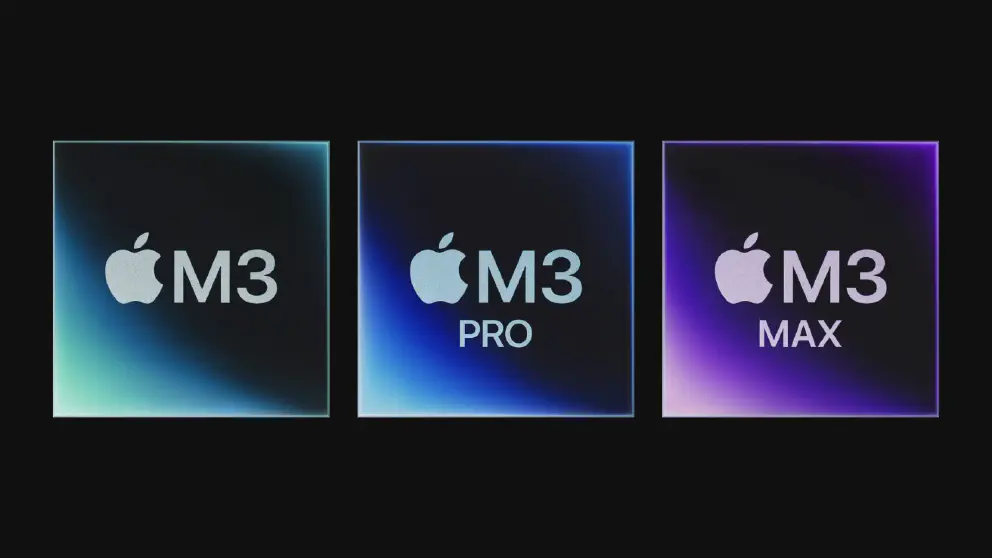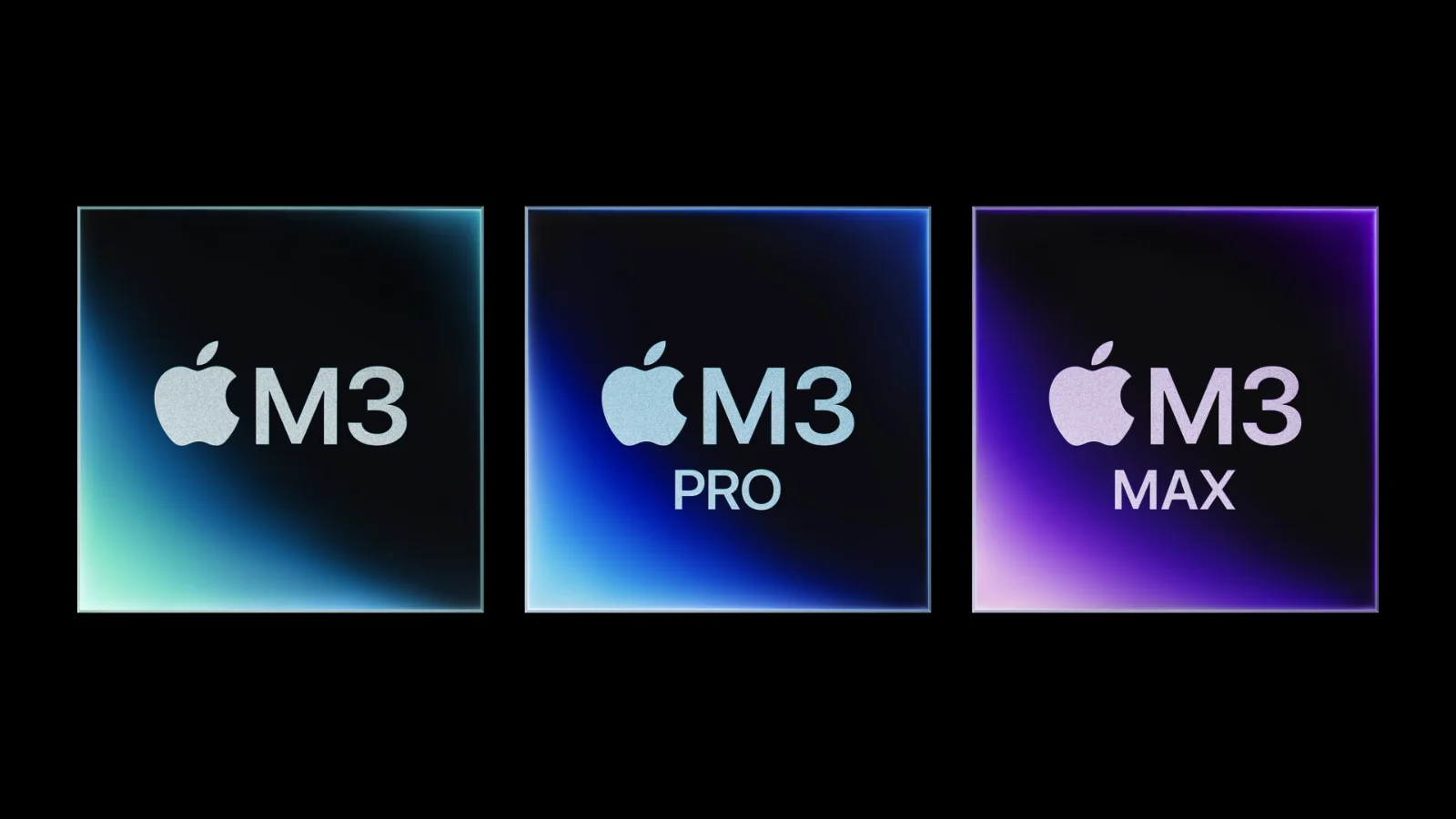
The M3 family of Apple Silicon was announced at Apple’s “Scary Fast” October event. Unlike previous events where Apple drips the introduction of Apple Silicon over a year, we get the top 3 most used Apple Silicon in one single shot.
Considering that Apple just introduced the M2 Pro and M2 Max earlier this year, it is a surprise move from Apple.
General Improvements
Here are the general improvements that the M3 family has:
- 3nm manufacturing: The first 3nm chip for general use was the A17 Pro that was used for the iPhone 15 Pro phones. That was September. Now Apple launched the first 3nm for mobile computers via the M3 family. Shrinking down the manufacturing process can give some performance improvements because the electrons take less time to get where they need to be.
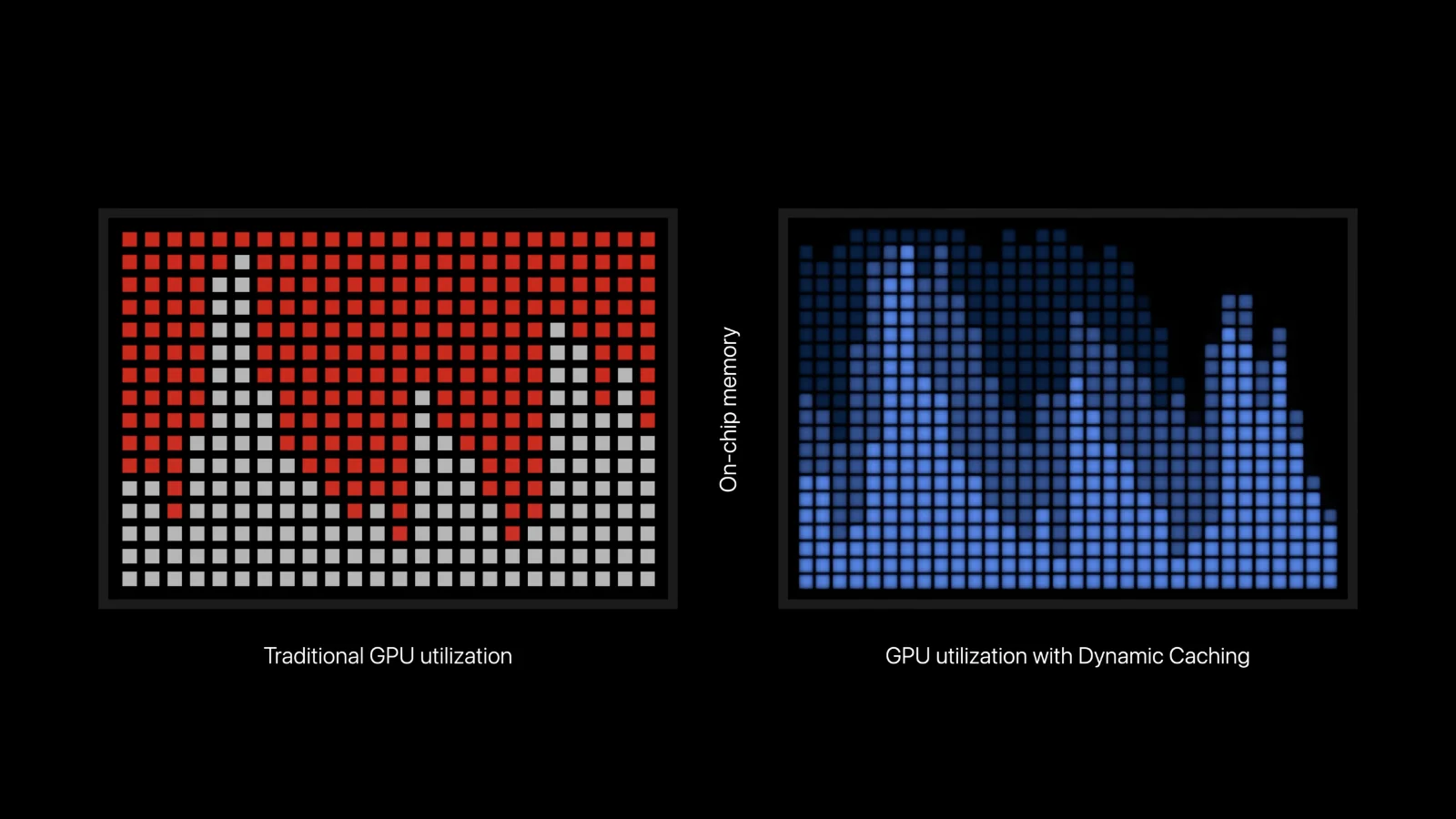
- Dynamic caching: When you start a program, the operating system will allocate a certain amount of memory for use by that program. Usually, the program will set how much memory it might need and the OS will comply. However, most program doesn’t use all the memory it requested all the time. This causes some form of allocation waste thus slowing down performance. Dynamic caching aims to solve this issue by dynamically allocating memory to programs in real-time, improving utilization rates.
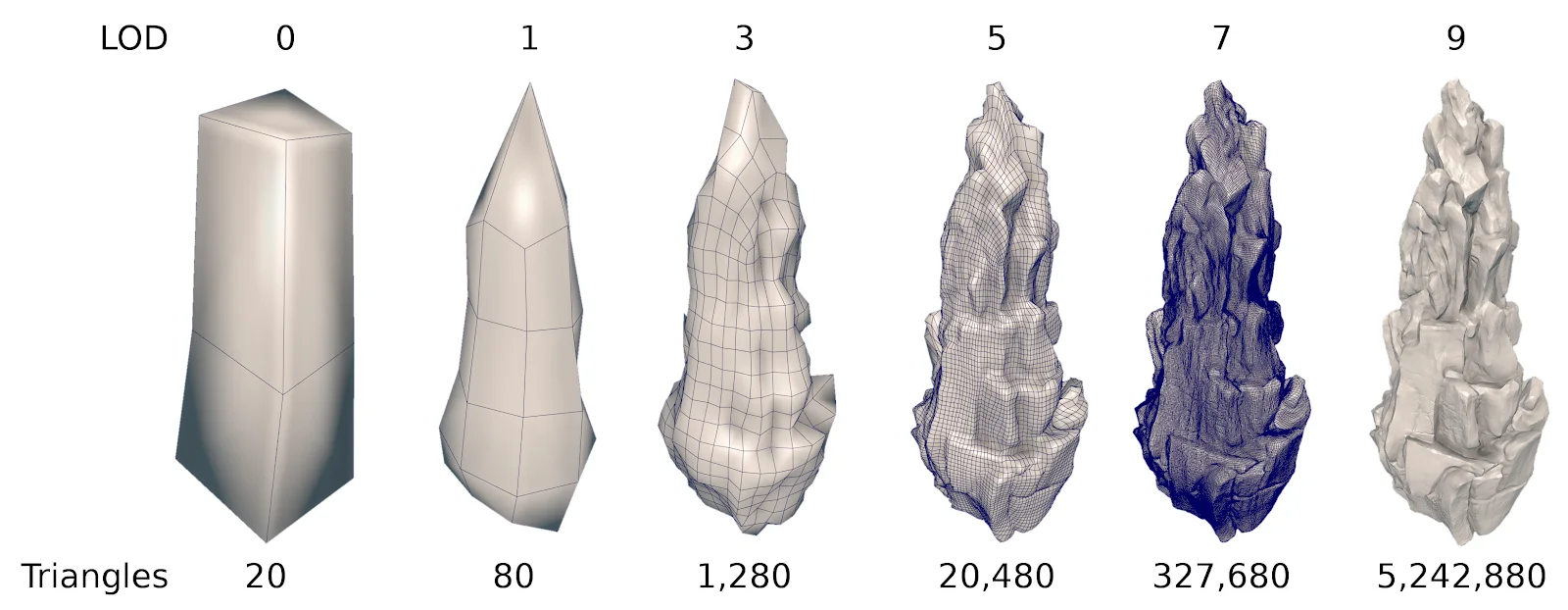
- Graphics: The biggest change in the M3 family is graphics.
Apple Silicon has been performing quite well against Intel and its brethren, but the major complaint is graphics power is not on par with Nvidia’s offerings. Apple bought some hardware accelerated to the table in hopes of turning things around. One piece of evidence is that the iPhone 15 Pro, a smartphone nevertheless, can play AAA games that were designed for consoles.
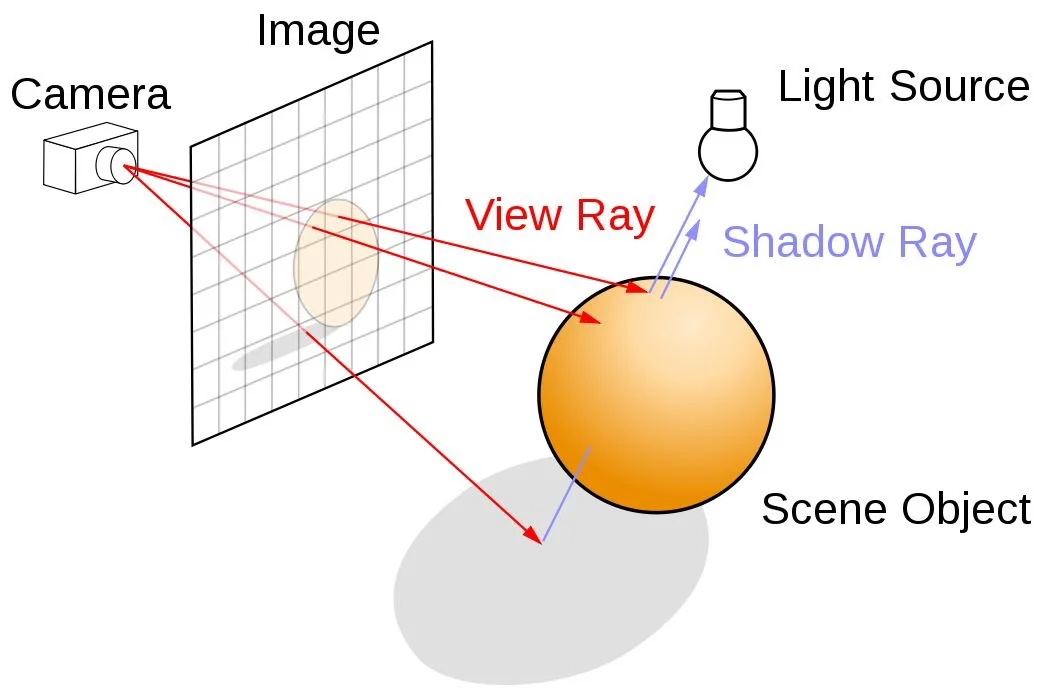
- Hardware accelerated ray tracing and mesh shaders: Ray tracing and mesh shaders are techniques in computer graphics to draw objects and illuminate them so they will look realistic and beautiful. It takes a lot of computing power to render the math and data, especially when you need to render each frame over 100 times a second. So specialized hardware circuits (or cores we call them) to do just that will improve performance significantly.
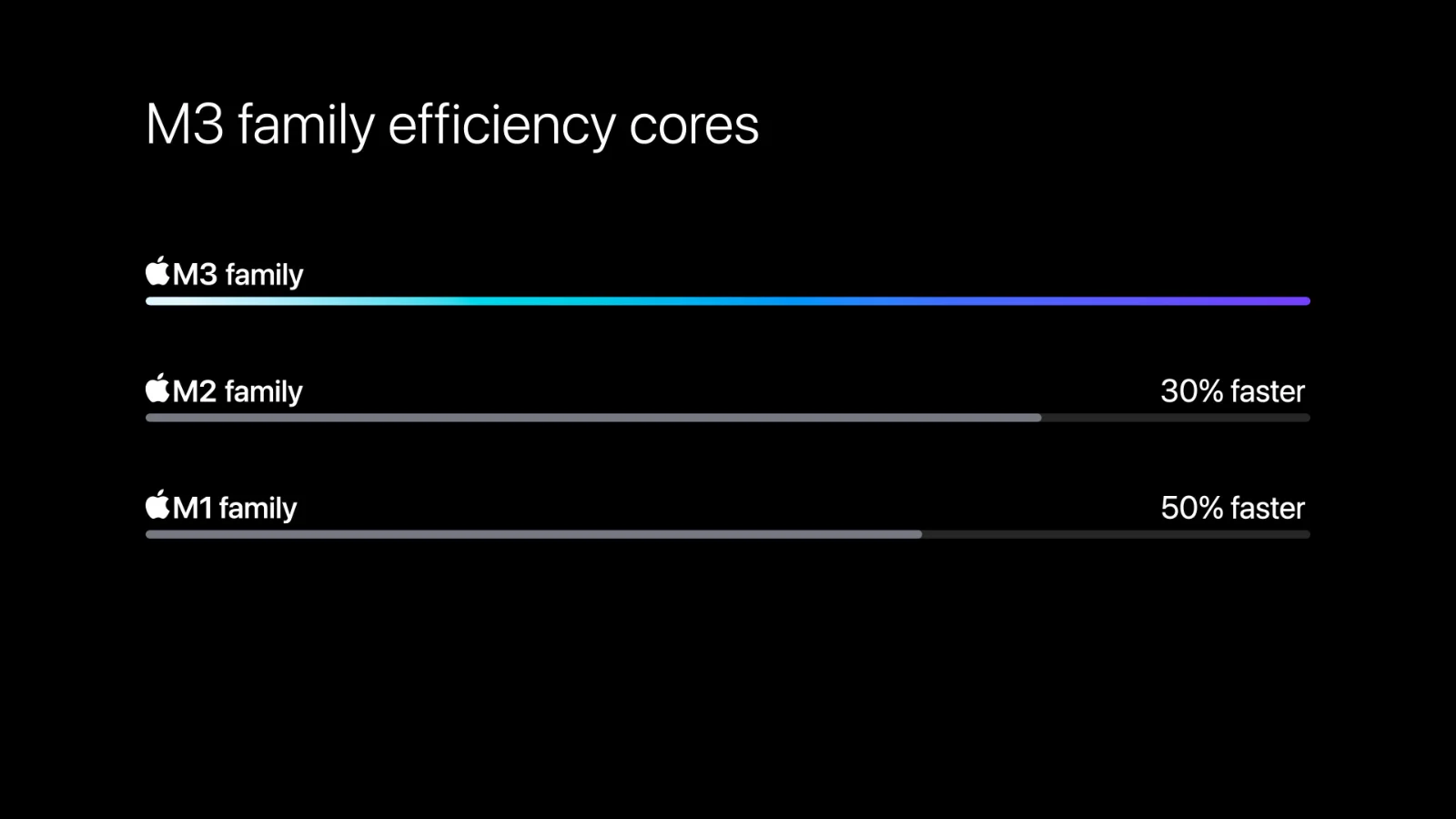
- Improved efficiency cores: While performance cores get the ladies, the efficiency cores pay the rent. Apple announced a big boost on efficiency cores, particularly against the original M1 chip. The thinking goes that if you get most of the basic stuff done quickly on the efficiency cores, things might feel faster.
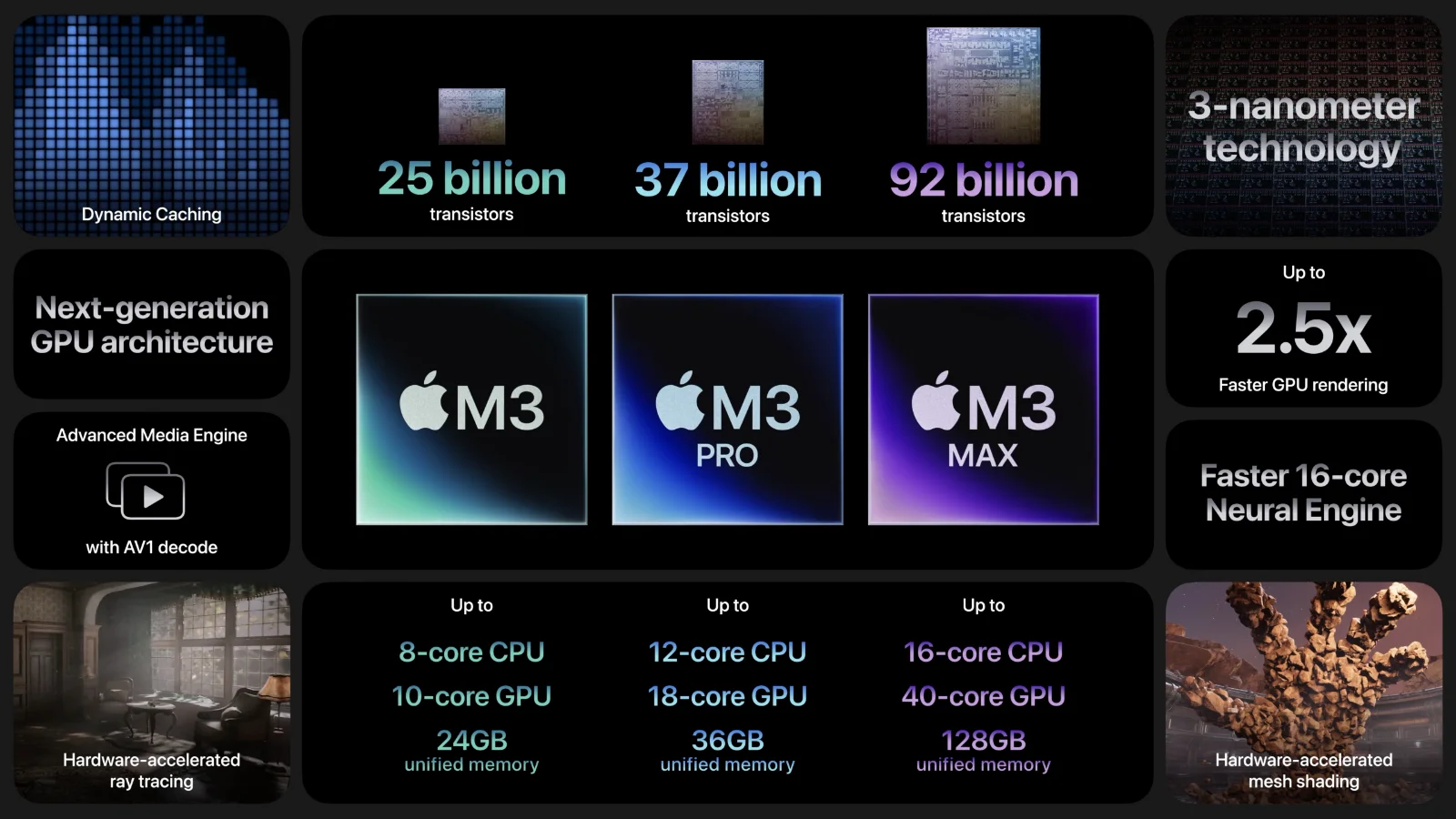
The M3 Family
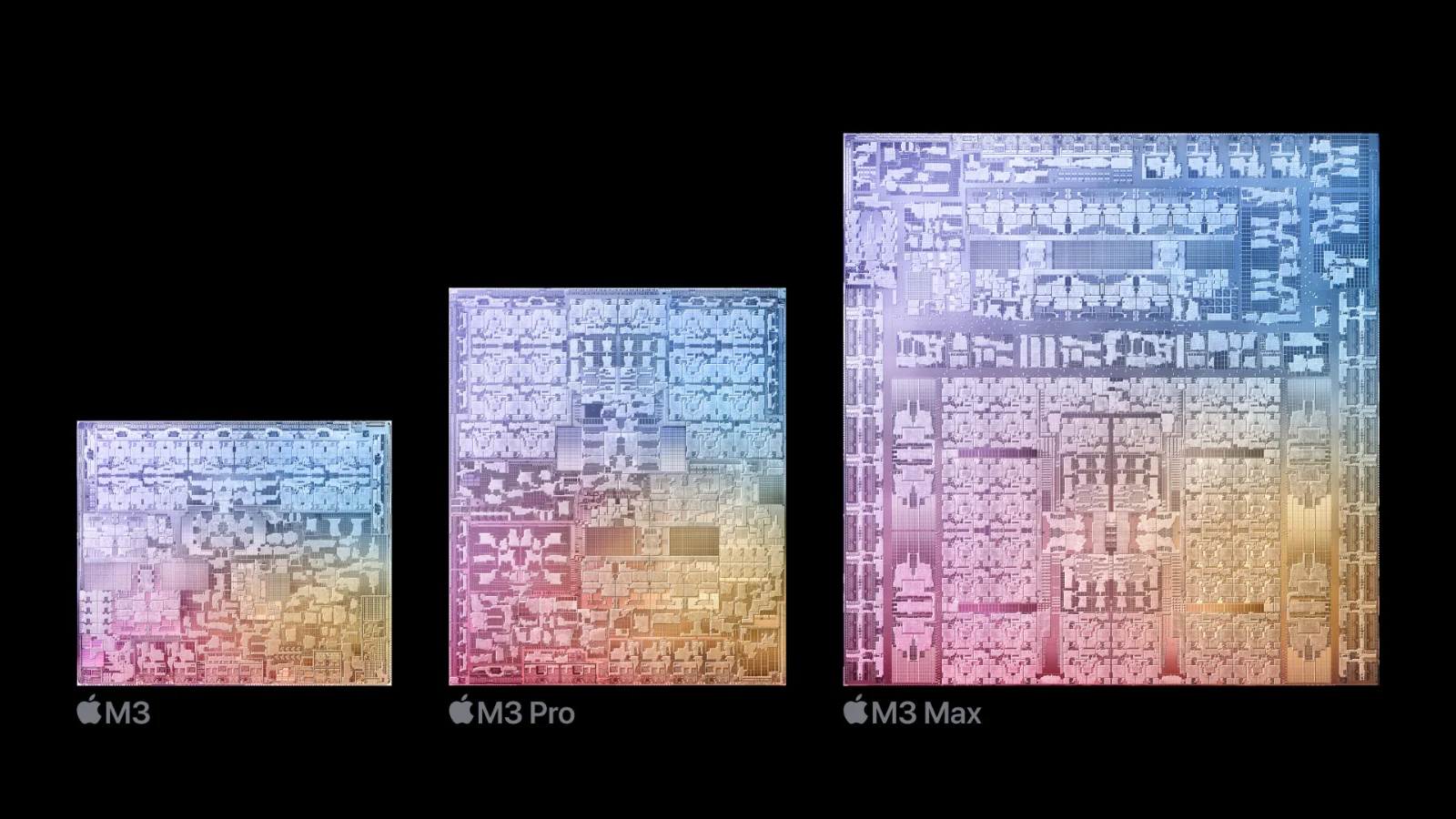
M3
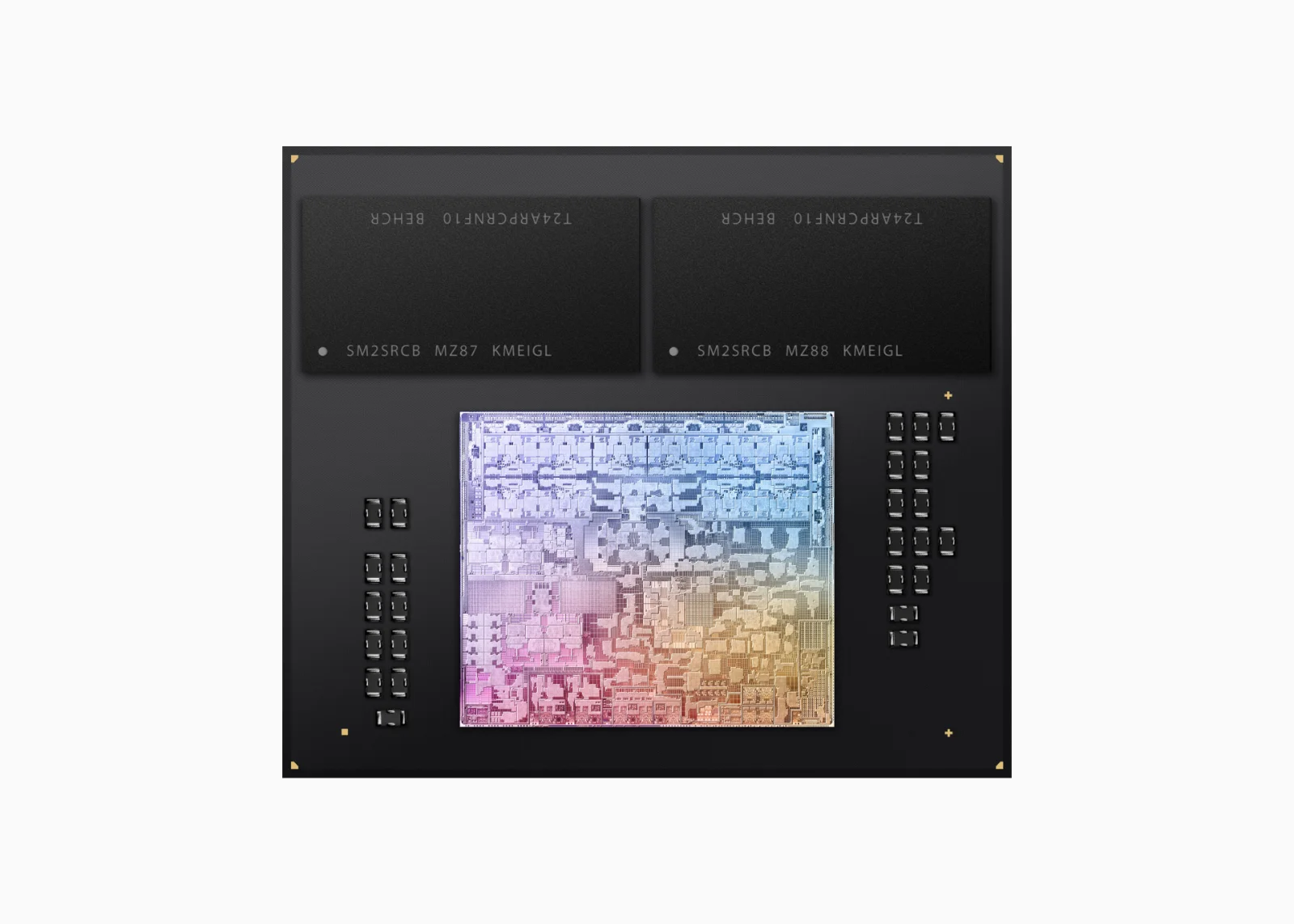
The M3 family begins with the base M3 chip. This will always be the most popular chip because it powers the most popular Macs: the MacBook Air, Mac Mini, iMac, and the base MacBook Pro. So, the M3 family could be considered the most important member of the family because it carries the banner. The M3 is destined to be in all popular Macs and iPads: Mac Mini, MacBook Air, MacBook Pro, iPad Pro, and even iPad Air
Some basic features and specs:
- 8-core CPU (4-performance, 4-efficiency) , 10-core GPU and a 16-core Neural Engine
- support up to 24GB of memory
- media engine that supports AV1, ProRes and other codecs.
Some info regarding the M3:
- Good base specs: 10-core CPU, 10-core GPU, 16-core Neural Engine brings the M3 a good all-rounder chip.
- Media Engine: The media engine, which was introduced in the M1 Pro/Max line is what allows the M3 to perform video processing efficiently. The result: you get a base laptop that can edit 4K ProRes videos while maintaining a 20+ hour battery life.
- 24GB memory support: Apple’s M3 devices can support up to 24GB of memory, enough to do a lot of things.
- Powers most popular Apple products: The M3 is the basic chip, powering the widest array of Apple products, from the iPad Air to the MacBook Pro. Their siblings the M3 Ultra and M3 Max might have the headlines about being the most performance-orientated, but the M3 is the most important chip Apple makes other than the one that powers the iPhone.
M3 Pro
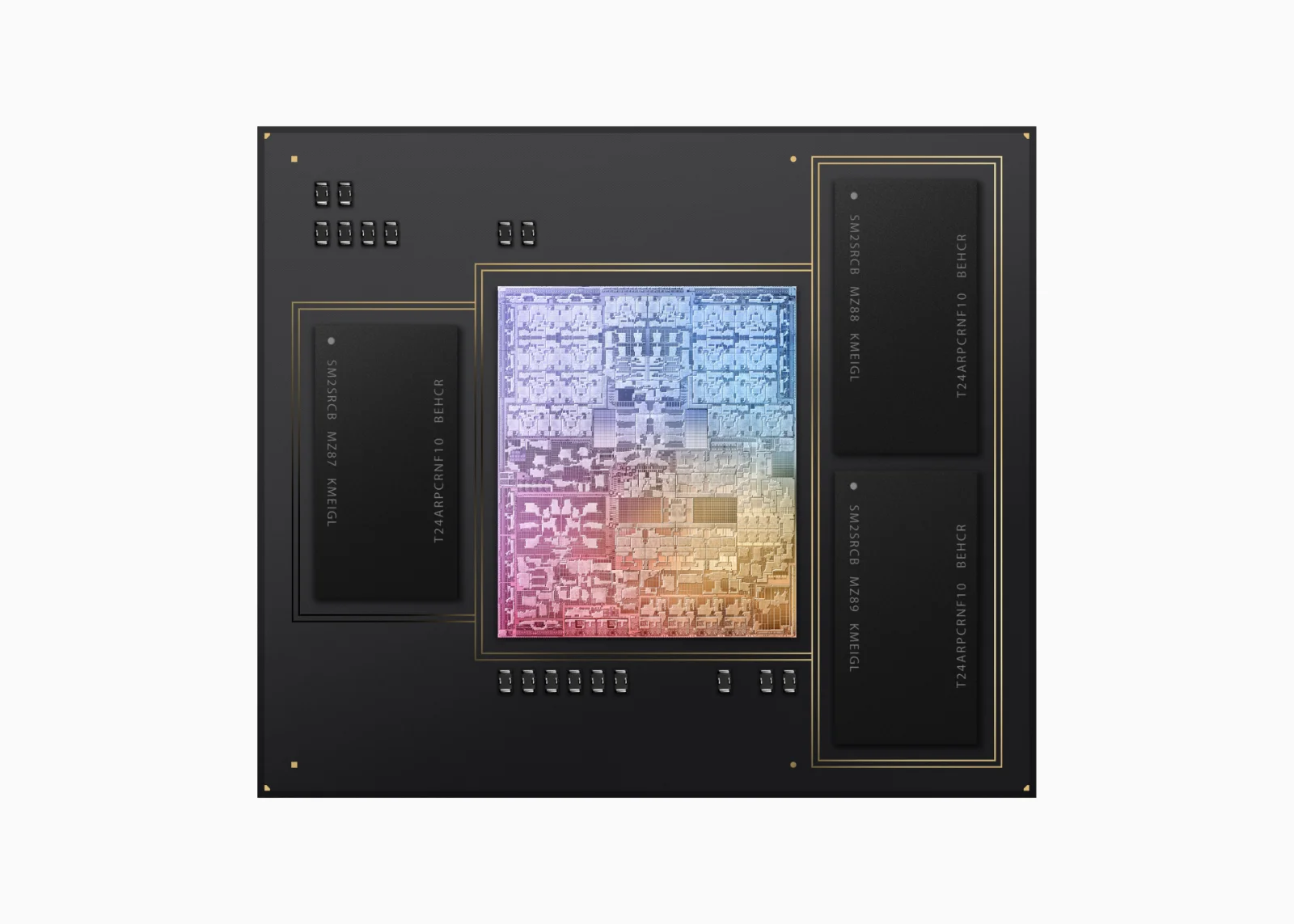
The M3 Pro is the first in a series of “performance” orientated Apple Silicon. Traditionally, the M3 Pro is a cut version of the M3 Max where the GPU cores sections of the M3 Max is cut to improve yields. For the M3 family, Apple decided to make the M3 Pro designs to be more distinguished than ever before.
Apple did some readjustments to the M3 Pro where it has fewer transistors than the M2 Pro. Despite having reduced memory bandwidth (150GB/s in the M3 Pro vs 200GB/s in the M2 Pro), performance hasn’t been reduced, but instead increased.
Basic Specs
- 12 CPU cores (6 performance, 6 efficiency), up to 18 GPU cores, and 16-core neural cores.
- Twice the number of media engine cores than the M3
- Memory bandwidth reduced from 200GB/s to 150GBs
- 18GB or 36GB of memory support.
- Display Engine to support
M3 Max
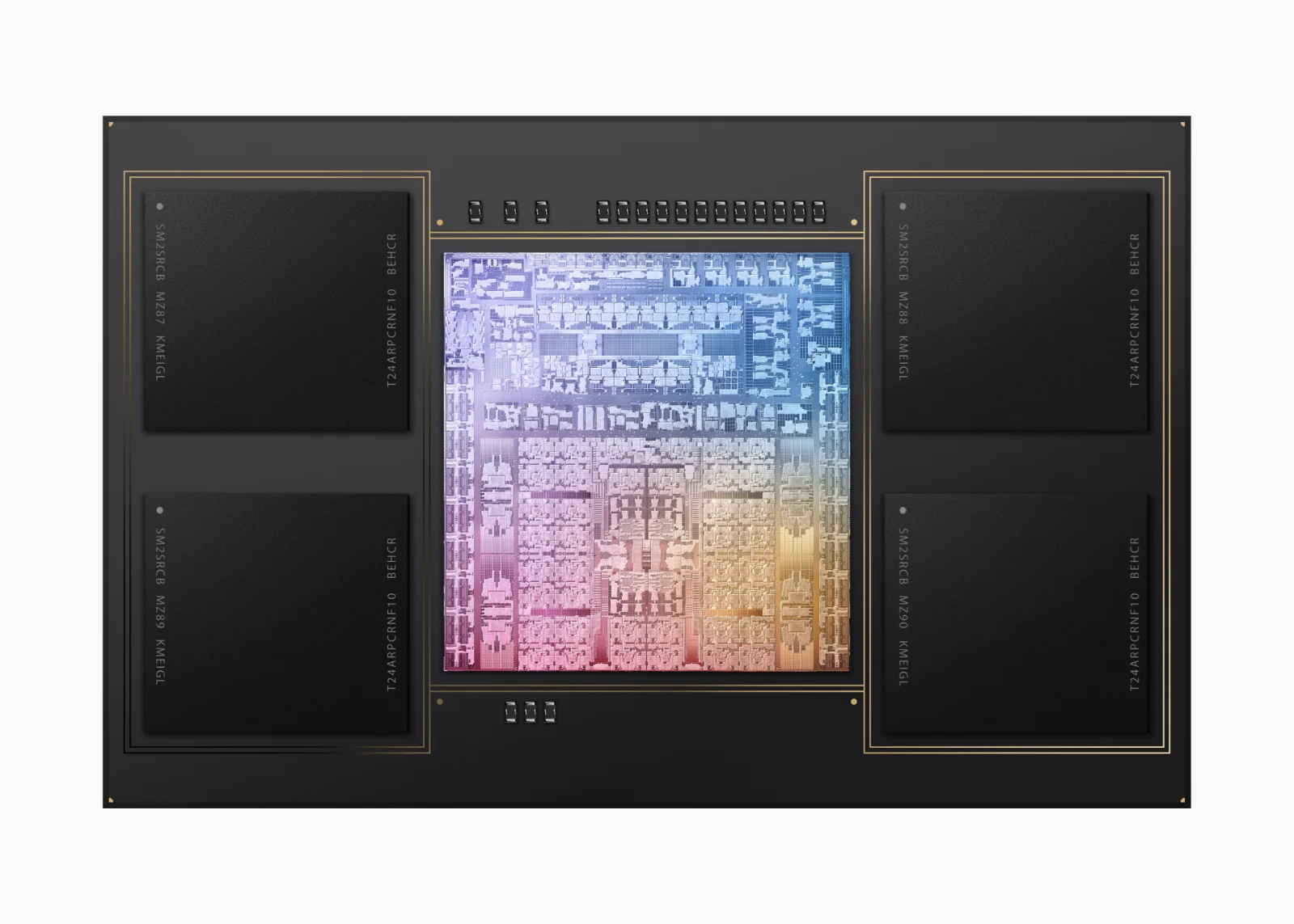
The M3 Max is the best mobile chip that Apple makes. Despite being designed for mobile computing, the M3 Max is performance-orientated to ensure that you have that punch - to go. Apple ensures that all the graphics and CPU cores can run on full performance - while on batteries, which a lot of Intel / Nvidia laptops unable to do
Basic specs:
- 16 CPU cores (12 performance, 4 efficiency); Up to 40 GPU cores, 16-core Neural Engine
- Have twice the media engine cores than the M3 Pro.
- Wide choice of installed memory: 32GB, 48GB, 64GB, 96GB, or 128 GB.
- 300GB/s of memory bandwidth, reduced from 400GB/s in the M2 Max. However, Apple managed to improve performance despite having less memory bandwidth and transistors.
M3 Ultra?
The speculated chip of the future in the M3 family will be the M3 Ultra. Like the M2 Ultra and M1 Ultra, the M3 Ultra is expected to fuse two M3 Max chips into a single huge chip called the M3 Ultra. Both of the M3 Max chips are connected via an interlink called UltraFusion. The interconnect speed will be fast enough that in the eyes of the operating system, it sees a single huge monolith of a chip instead of two discreet chips. Usually, this setup will vastly improve performance and simplify work for programmers to take advantage of the chip. It is expected that the M3 Ultra will be destined for Mac Studio and Mac Pro.
Predicted specs (based on M3 Max):
- 32-core CPU (24 performance cores & 8 efficiency cores), Up to 80 GPU cores, dual 16-core neural cores
- up to 256 GB of memory support
- 8 media engine
- I/O cores to support Thunderbolt 4 and possibly higher.
M3 Extreme??
There was a persistent rumor that Apple was making a more capable version of the Ultra chip to be used by the most demanding macOS user. After all, the Intel Mac Pro uses Intel’s most powerful chip in their line-up the Intel Xeon which was used in the high-end workstation market. Alas, Apple finally updated the Mac Pro to only include an M2 Ultra. The Mac Pro is now regulated to a Mac Studio with PCIe extensions. Will Apple finally introduce a more powerful version of the M3 Ultra? Time will tell if they are willing to do so.
Performance
There is no doubt that Apple’s newer generation’s chip is more performant than the previous one. No semiconductor company is selling something that is less performing than the previous generation. We all know that. What is more important is how competitive are Apple chips against their rivals from Intel, AMD, and more recently, Qualcomm.
Apple claims that its chip is at least 15% faster than the previous generation and around 30% faster than the M1 generation. Moreover, performance is focused on efficiency cores which Apple claims a 50% improvement against the M1 generation.
Graphics is where Apple’s focus is on the M3 generation. Hardware acceleration is the name of the game with ray-tracing and mesh shading has been hardware accelerated. This improves gaming performance, an area that Apple is trying to wrestle from the PC world. The fact that Apple can run AAA console games right from the iPhone 15 Pro lends some credibility in this area.
Power consumption is something that Apple is a front that Apple is leading. While mobile gaming laptops can be faster than Apple’s MacBook Pro, the MacBook Pro maintains the performance envelope even in battery mode, something that the Nvidia/Intel counterpart hasn’t done yet.
Publications like Arstechnica have shown that the Apple M3 family is competitive against Intel’s offering but power consumption is where Apple holds the edge.
Furthermore, X (formally Twitter) user Tailosivetech has shown that in terms of CPU power, the basic M3 seems to be on par with the M1 Pro so the M3 MacBook Pro is not a pushover as a lot of people used to think.
There are also reports that the M3 Max CPU performance is as high as the recently launched M2 Ultra in benchmarks. We will have to verify that report.
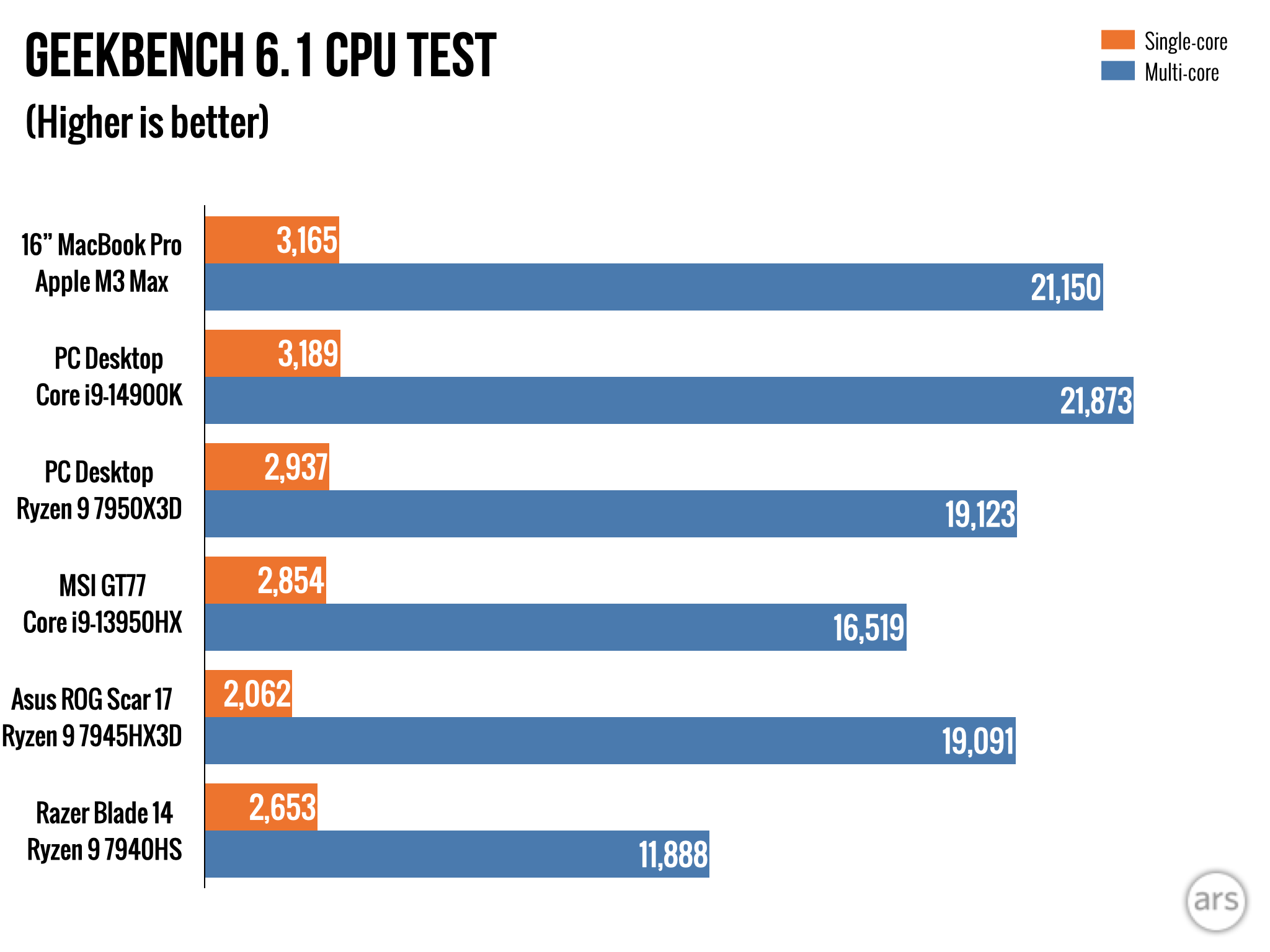

Tailosive Tech has shown that the lowly M3 chip is more performant than the M1 Max.Geekbench 6 CPU Benchmark:
— Tailosive Tech (@TailosiveTech) November 8, 2023
M3 VS M1 Max pic.twitter.com/b12ufP8N8X
Observations & Conclusions
The M2 Pro and M2 Max Macs were introduced in January of this year. It’s very unusual for Apple to replace it in less than a year. What this means is that the competition for laptop chips, which was stagnant for several years, has been recently heating up. This can be seen by Intel making radical changes to their Core processor and competitors like Qualcomm, which include ex-Apple engineers that worked on the M1 generation, have entered the competition.
Another curious thing to see is that the M3 Pro has an in-house design instead of the expected cut-down version of the M3 Max. This shows a design paradigm shift of the Apple Silicon group from making the M3 Pro a cut-down version of the M3 Max to a beefier version of the base M3.
Apple’s new focus is now on graphics power instead of CPU power alone. It is to address one of the first two Apple Silicon generation pitfalls which the CPU power is very competitive against Intel’s solution but lagging far behind in GPU power from leaders like Nvidia. Apple although the best when on batteries, is no match in terms of raw power that Nvidia provides. Gaming, after all, is a multi-billion-dollar business that Apple hasn’t conquered yet. At least on the mainstream front.
While it is exciting to see Apple come up with newer and newer chips that compete well in the market, do note that the chips are not the end goal for Apple. The true goal of Apple is to capture the market where their users use their products every day and within their ecosystem. The Apple Silicon is the means to that goal.
Plug
Support this free website by visiting my Amazon affiliate links. Any purchase you make will give me a cut without any extra cost to you
| Base | Pro | |
|---|---|---|
| iPhones | iPhone 15 / iPhone 15 Plus (Renewed) - (Amazon) | iPhone 15 Pro / iPhone 15 Pro Max (Renewed) - (Amazon) |
| Watch | Apple Watch SE (Amazon) / Apple Watch Series 9 (Amazon) | Apple Watch Ultra 2 (Amazon) |
| AirPods | AirPods 3 (Amazon) | AirPods Pro 2 (Amazon) / AirPods Max (Amazon) |
| iPad | iPad 10 (Amazon) / iPad Mini (Amazon) | iPad Air M2 (Amazon) / iPad Pro M4 (Amazon) |
| Laptops | MacBook Air M3 (Amazon) | MacBook Pro M3 (Amazon) / MacBook Pro M3 Pro/Max (Amazon) |
| Desktop | Mac Mini (Amazon) / iMac (Amazon) | Mac Studio / Mac Pro |
| Displays | Studio Display (Amazon) | Pro Display XDR (Amazon) |
Other Ecosystem Items
